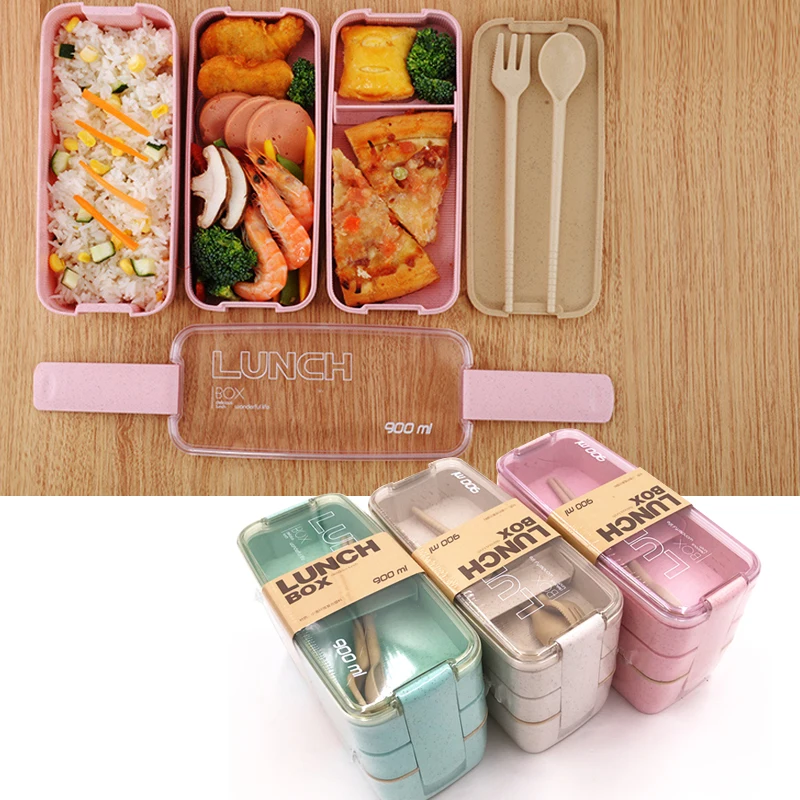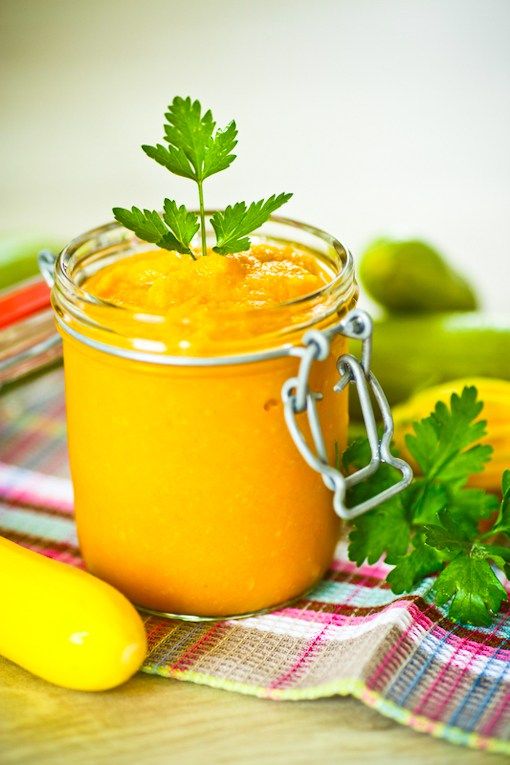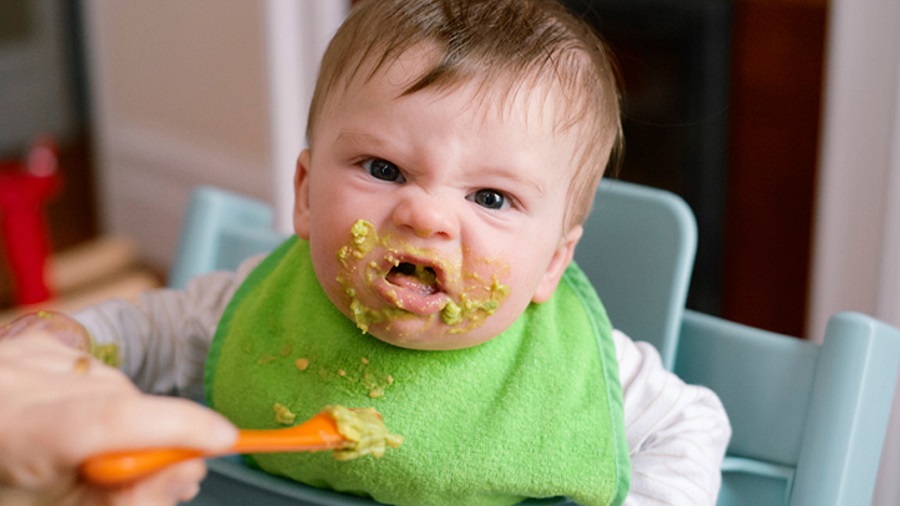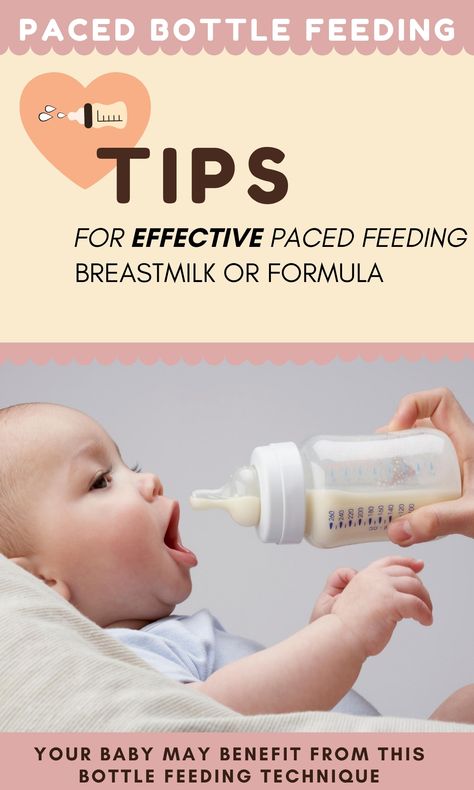What to feed your baby when
Age-by-age guide to feeding your toddler
- Community
- Getting Pregnant
- Pregnancy
- Baby names
- Baby
- Toddler
- Child
- Health
- Family
- Courses
- Registry Builder
- Baby Products
Advertisement
Your growing toddler can enjoy a wide range of foods. Expect your little one to have about 2 cups of milk or yogurt, 3 ounces of whole grains, 1 cup each of fruit and vegetables, and 2 ounces of protein a day. Help your toddler eat well by offering healthy foods including dairy products, iron-fortified cereals, whole grains, fruit, vegetables, and protein. Limit added sugars and watch out for choking hazards. It's fine to give your toddler a vegan or vegetarian diet as long as you make sure to include enough essential nutrients.
Photo credit: Thinkstock
Use this guide to find out what and how much to feed your toddler. Don't worry if your child eats more or less than the amounts suggested – they're meant as general guidelines.
Your toddler may actually seem to eat less than before, and that's perfectly normal at this stage. If you wonder whether your child is getting enough calories, follow this guideline: The American Academy of Pediatrics recommends that children get about 40 calories a day for every inch of height.
(See our article about what to feed children younger 12 months.)
What to feed a 1-year-old
Developmental milestones
- Can use a spoon (though proficiency will take a while!)
What to feed
- Whole milk
- Other dairy products (soft pasteurized cheese, full-fat yogurt and cottage cheese)
- Iron-fortified cereals (oats, barley, wheat, mixed cereals)
- Other grains (whole wheat bread, pasta, rice)
- Fruits (melon, papaya, apricot, grapefruit)
- Vegetables (broccoli and cauliflower "trees," cooked until soft)
- Protein (eggs, beans, thinly spread peanut butter, small pieces of meat, poultry, boneless fish, or tofu)
- Honey
How much per day
- 2 cups milk, or 2 cups yogurt, or 1 1/2 to 2 ounces cheese
- 3 ounces grains, at least half whole grains (1 ounce = 1 cup cold cereal, 1/2 cup pasta or rice, one slice of bread)
- 1 cup fruit (fresh, frozen, or canned.
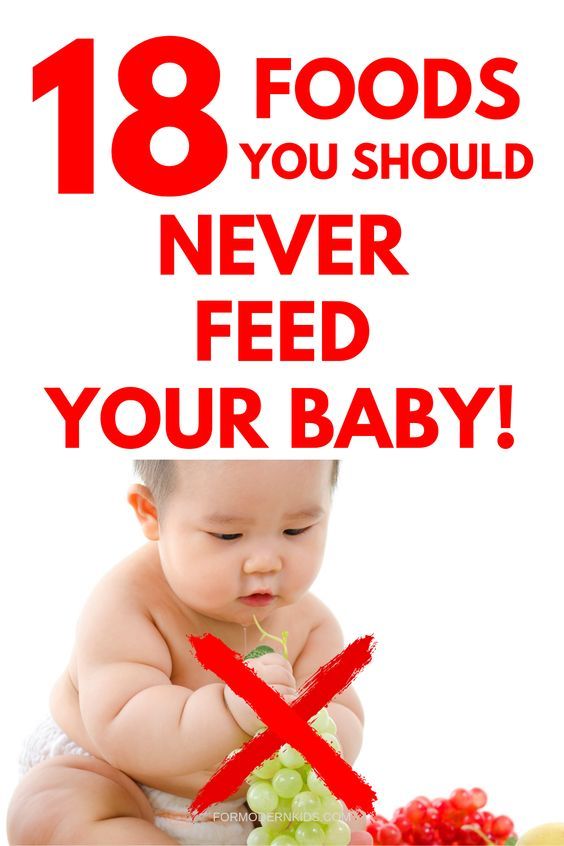 Cut fresh fruits into very small pieces.)
Cut fresh fruits into very small pieces.) - 1 cup vegetables (a variety cut in small pieces and cooked well)
- 2 ounces protein (1 ounce = one slice of sandwich meat, about 1/3 of a chicken breast, 1/4 can of tuna, 1/4 cup cooked dry beans, or one egg)
Advertisement | page continues below
Feeding tips
- Experts used to say you shouldn't give a young child eggs, fish, or peanut products because the child might develop a food allergy. But the latest research from the American Academy of Pediatrics found no evidence to support this claim. Talk to your child's doctor if you have a family history of food allergies.
- Limit added sugars. Toddlers' added-sugar intake should be no more than 10 percent of their total daily calories. Keep in mind that these sugars and syrups creep into common foods toddlers love, from breakfast bars to mac n' cheese to flavored drinks. Check the Nutrition Facts label on packaged foods, and try to steer clear of foods that list 1 gram or more of "Added Sugars.
 "
" - Choking is still a danger. Learn more about which foods pose the greatest hazard.
What to feed a 2-year-old
Developmental milestones
- Self-feeding
- Eagerness to make own food choices
What to feed
- Low-fat milk (It's okay to switch to low-fat or nonfat milk once your child is older than 2, but check with your child's doctor if you have questions.)
- Other dairy products (diced or grated cheese, low-fat yogurt, cottage cheese, pudding)
- Iron-fortified cereals (oats, barley, wheat, mixed cereals)
- Other grains (whole wheat bread and crackers, bagel pieces, pretzels, ready-to-eat cereal, pasta, rice)
- Fruits (sliced fresh or canned)
- Dried fruit, soaked until soft to prevent choking (apples, apricots, peaches, pears, dates, pitted prunes)
- Vegetables (a variety cut in small pieces and cooked well)
- Protein (eggs, beans, thinly spread peanut butter, small pieces of meat, poultry, boneless fish, or tofu)
- Combo foods like macaroni and cheese, casseroles
How much per day
- 2 cups milk, or 2 cups yogurt, or 1 1/2 to 2 ounces cheese
- 3 ounces grains, at least half whole grains (1 ounce = one slice of bread, 1 cup ready-to-eat cereal, or 1/2 cup of cooked rice, cooked whole wheat pasta, or cooked oatmeal)
- 1 cup fruit (fresh, frozen, canned, or dried.
 Cut fresh fruits into very small pieces.)
Cut fresh fruits into very small pieces.) - 1 cup vegetables (a variety cut in small pieces and cooked well)
- 2 ounces protein (1 ounce = 1/4 cup cooked dry beans or peas, one egg, 1 ounce of meat, poultry, or fish)
Feeding tips
- Experts used to say you shouldn't give a young child eggs, fish, or peanut products because the child might develop a food allergy. But the latest research from the American Academy of Pediatrics found no evidence to support this claim. Talk to your child's doctor if you have a family history of food allergies.
- Limit added sugars. Toddlers' added-sugar intake should be no more than 10 percent of their total daily calories. Keep in mind that these sugars and syrups creep into common foods toddlers love, from breakfast bars to mac n' cheese to flavored drinks. Check the Nutrition Facts label on packaged foods, and try to steer clear of foods that list 1 gram or more of "Added Sugars."
- At this age, children can have strong opinions about food.
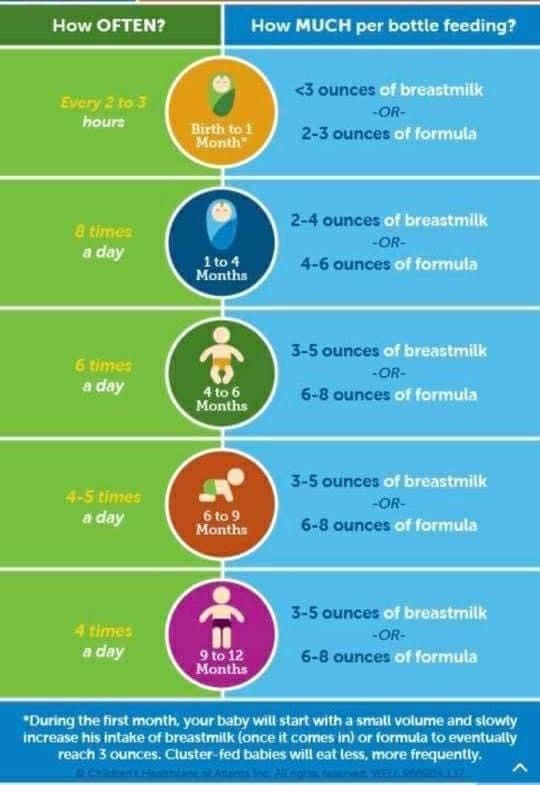 Let your child have a say in what to eat, while you provide the balance, boundaries, and encouragement to make healthy choices.
Let your child have a say in what to eat, while you provide the balance, boundaries, and encouragement to make healthy choices. - Choking is still a danger. Learn more about which foods pose the greatest hazard.
What if we're vegetarians?
If you're a vegan or vegetarian, you can still provide your infant or toddler with everything she needs. The Academy of Nutrition and Dietetics and American Academy of Pediatrics agree that well-planned vegetarian and vegan diets are fine for infants and toddlers. Just pay attention to make sure your child gets plenty of the following nutrients:
- Vitamin B12: Vegetarians can get this nutrient from milk products and eggs. Vegans can use fortified soy beverages, cereals, and meat substitutes.
- Vitamin D: Breastfed babies should get an additional 400 IU per day from fortified cow's milk or soy milk.
- Calcium: Vegan babies may need calcium-fortified foods, beverages, or supplements.
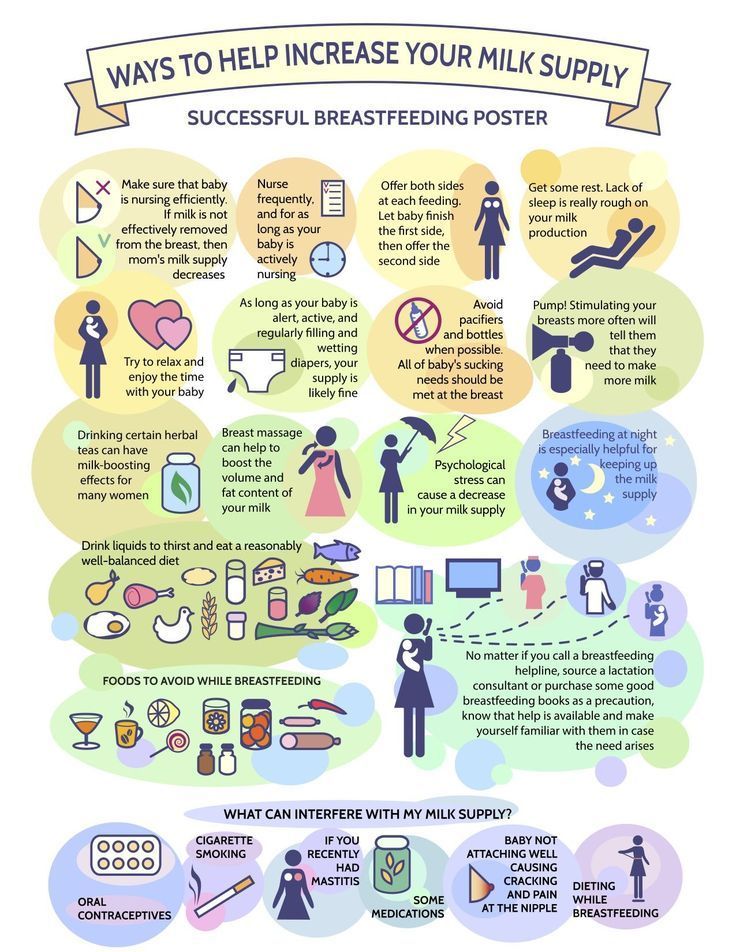 Check with your doctor or a dietitian.
Check with your doctor or a dietitian. - Zinc: This important nutrient helps the immune system and can be found in beans, fortified cereal, milk, and wheat germ.
- Iron: You can find this mineral in iron-fortified cereal or supplements. Serve with foods high in vitamin C – like oranges, tomatoes, and strawberries – to improve iron absorption.
- Protein: Vegetarians can get added protein from yogurt and eggs. Vegans can get plant proteins from beans, cereals, and fortified soy milk.
- Fiber: Good sources of fiber include whole grain breads, fortified cereals and pastas, and high-fat plant foods like sunflower butter and avocados.
Was this article helpful?
Yes
No
Karisa Ding
Karisa Ding is a freelance health writer and editor with expertise in preconception, pregnancy, and parenting content. A mother of two, Ding finds great joy in supporting new and expectant parents by providing information they need for the life-changing journey ahead.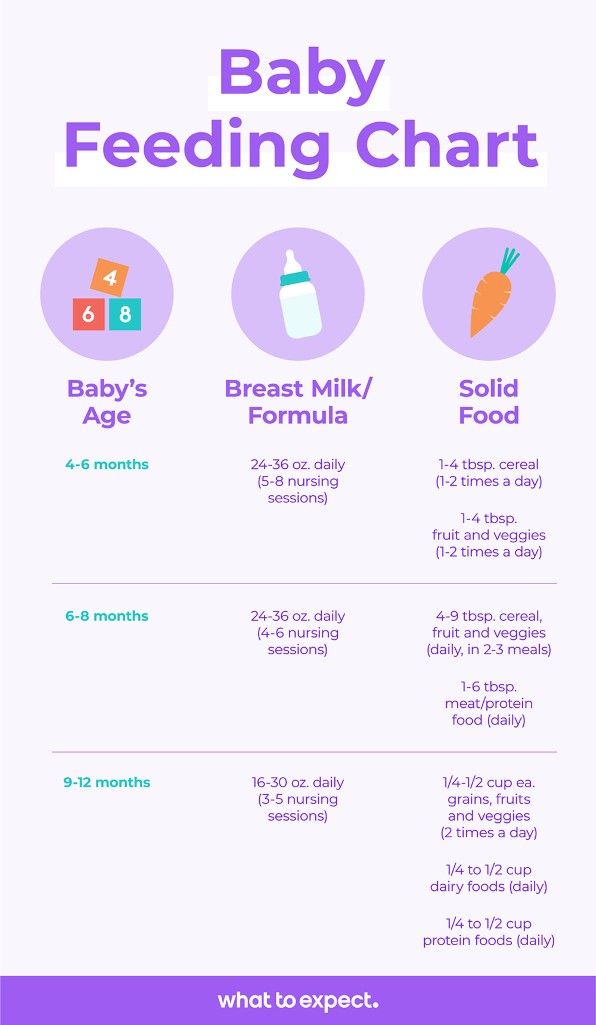 Ding lives in San Francisco with her family.
Ding lives in San Francisco with her family.
How much should my baby eat? A guide to baby food portions
- Community
- Getting Pregnant
- Pregnancy
- Baby names
- Baby
- Toddler
- Child
- Health
- Family
- Courses
- Registry Builder
- Baby Products
Advertisement
Wondering how much to feed your baby? This can be hard to figure out, especially when you're starting solids and most of your baby's food ends up on your little one or the floor. It's also difficult to determine how much an 8-month-old (or older baby) should eat – babies this age are more interested in solid foods but still get most of their nutrition from breast milk or formula. This visual guide to baby food portions can help you figure out how much your baby should eat at every stage.
Photo credit: Karla Martin for BabyCenter
How much should my baby eat?
Do you worry that your baby is eating too little or too much? Your baby will self-regulate her food intake based on what their body needs, so let their appetite be your guide.
It's helpful to have a reference point, however. Here are photos of how much solid food a baby typically eats in a day. You can also ask your baby's doctor for feeding advice.
This visual guide shows:
- Portions for infants who are new to solids (typically 4 to 6 months)
- Two sample meals for a younger baby (6 to 8 months)
- Three sample meals and two snacks for an older baby (8 to 12 months) from a menu developed by the American Academy of Pediatrics (AAP)
Your little one may eat less or more than what's shown here. Your job is to provide a variety of healthy foods at regular intervals without pressure, and their job is to decide what and how much to eat.
Photo credit: iStock.com / UntitledImages
Watch for signs your baby is full
Lots of factors – including activity level, growth spurts or plateaus, illness, and teething – will affect your baby's appetite, which can vary daily.
End feeding when they signal that they're done. Signs of being full include:
Signs of being full include:
- Turning their head away
- Refusing to open their mouth for another bite after they've swallowed (resist the urge to encourage your baby to have one last spoonful)
- Leaning back in their chair
- Playing with the spoon or food rather than eating
Photo credit: Karla Martin for BabyCenter
How much a 4- to 6-month-old should eat
When your baby is developmentally ready for solids, typically around 4 to 6 months, talk to their doctor about introducing solid foods. The first bites are mostly about them getting used to the idea of having something different in their mouth.
- Start with a very small amount, 1 to 2 teaspoons, of a single-ingredient puree.
- Gradually increase to 1 to 2 tablespoons of food once a day.
- Follow your baby's fullness cues.
Popular first foods include pureed mango, banana, chicken, turkey, beef, peas, sweet potatoes, and infant cereal. It's up to you what food to start with, but wait 3 to 5 days between introducing each new food to make sure your baby doesn't have an allergic reaction or food intolerance. (And remember, no cow's milk or honey until age 1.)
It's up to you what food to start with, but wait 3 to 5 days between introducing each new food to make sure your baby doesn't have an allergic reaction or food intolerance. (And remember, no cow's milk or honey until age 1.)
Photo credit: Karla Martin for BabyCenter
How much a 6- to 8-month-old should eat
As your little one gets more comfortable with solids, you can increase the frequency of meals and variety of food.
- Transition from one to two meals a day, typically by 8 months.
- Over time, add a second food to each meal. The photo above is an example of a meal with two foods.
- Once you've worked up to two meals with two foods each, aim for a balance of proteins, vegetables, fruits, and grains in their daily diet.
- Whenever you introduce a new food, start with a very small amount, a teaspoon or two, to allow your baby to get used to its flavor and texture.
- Start with a soupy consistency. Gradually add more texture as their eating skills improve.
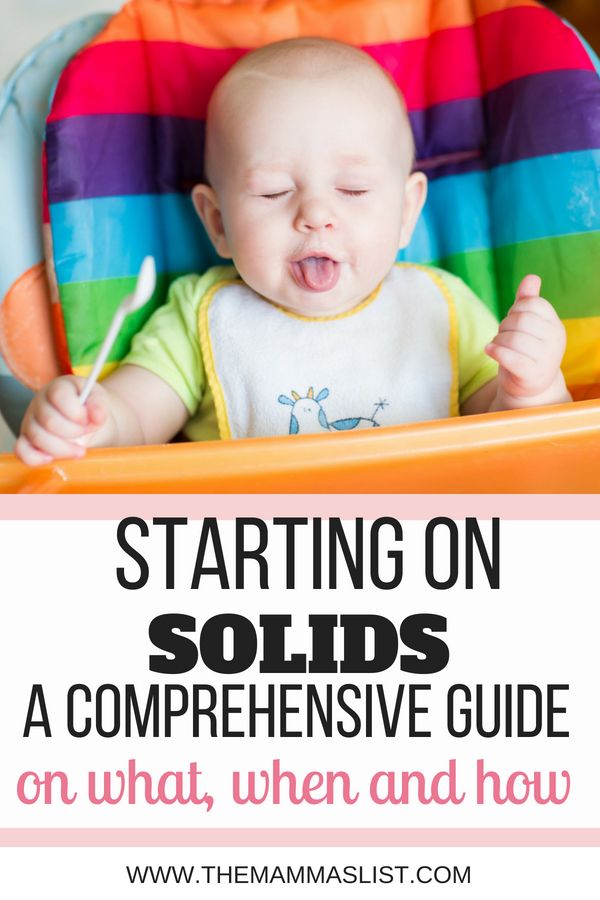
Expect their intake of breast milk or formula to go down. They'll start drinking less of it as they eat more solid foods. Provide healthy options at mealtimes, and let them choose how much to eat.
Note: The jars in all photos are standard 4-ounce baby food jars.
Photo credit: Karla Martin for BabyCenter
Breakfast for a younger baby (6 to 8 months)
Cereal and fruit make an easy combination for a morning meal.
Grain: Iron-fortified, whole-grain infant cereal is a popular first grain. At 6 months, a typical daily portion of infant cereal mixed with breast milk or formula might be 2 to 3 tablespoons, increasing to 4 to 8 tablespoons (1/4 to 1/2 cup) by 8 months. (It's best to avoid rice cereal, though.)
Fruit: Babies love the natural sweetness of fruits like pears, apples, berries, prunes, and stone fruits. Between 6 and 8 months, a baby will typically transition from about 2 to 3 tablespoons of fruit puree a day to 4 to 8 tablespoons (1/4 to 1/2 cup) of mashed or minced fruit.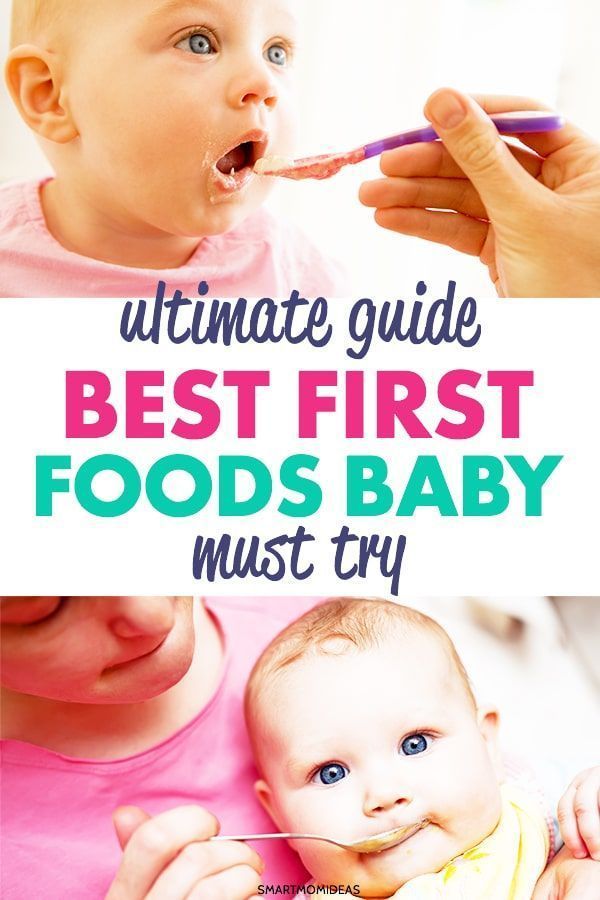
Photo credit: Karla Martin for BabyCenter
Dinner for a younger baby (6 to 8 months)
If you serve a grain and fruit in the morning, consider offering a protein-rich food and vegetable later in the day. Your child may eat more or less than the amounts shown.
Protein: A baby might transition from eating 1 to 2 tablespoons of meat puree at 6 months to 2 to 4 tablespoons at 8 months, for example. Other good protein sources include cheese, unsweetened plain whole-milk yogurt, tofu, beans, and lentils.
Vegetables: Between 6 and 8 months, a baby will typically transition from about 2 to 3 tablespoons of vegetable puree a day to 4 to 8 tablespoons (1/4 to 1/2 cup). Try classic favorites like carrots, spinach, or butternut squash, as well as less traditional first foods such as parsnips, beets, or asparagus.
As your child's eating skills improve, gradually add more texture by dicing or mincing foods.
Photo credit: Karla Martin for BabyCenter
How much an 8- to 12-month-old should eat
By 8 months or so, your baby is likely getting the hang of eating and needs to eat more calories to support their growing body. But since their little belly can't hold a lot of food, they'll need to eat more often. Every baby is different, but this may be a good time to try offering a third solid food meal.
But since their little belly can't hold a lot of food, they'll need to eat more often. Every baby is different, but this may be a good time to try offering a third solid food meal.
During this period:
- Continue to give your baby breast milk or formula.
- Add morning and afternoon snacks. (Some babies this age are happy with breast milk or formula as their snack, while others gravitate toward solid foods.) Once you've added a third meal and snacks, your baby will be eating or drinking something about every two to three hours.
- Continue to aim for a mix of proteins, vegetables, fruits, and grains.
- Introduce coarser and chunkier textures, for example, by dicing or mincing food instead of pureeing it, and graduate to soft finger foods as your baby's eating skills improve.
- Avoid foods with added sugars. Check the Nutrition Facts label on packaged foods, and try to steer clear of foods that list 1 gram or more of "Added Sugars.
 "
" - Provide healthy options, and let your baby choose how much to eat.
To visualize daily portions for an 8- to 12-month-old, check out the following photos of a typical day's menu for a baby this age, developed by the AAP.
Your child may eat more or less than these amounts. If you're concerned about how much your baby is eating, talk to their doctor for advice.
Photo credit: Karla Martin for BabyCenter
Breakfast for an older baby (8 to 12 months)
The AAP sample menu for a baby 8 to 12 months features a breakfast consisting of:
- 4 to 8 tablespoons (1/4 to 1/2 cup) whole-grain infant cereal mixed with formula or breast milk
- 4 to 8 tablespoons (1/4 to 1/2 cup) diced fruit
Note: This is an example. Your baby may eat different foods and amounts.
Photo credit: Karla Martin for BabyCenter
Morning snack for an older baby (8 to 12 months)
The AAP sample menu for a baby 8 to 12 months features a morning snack consisting of:
- 4 tablespoons (1/4 cup) diced cheese or cooked vegetables
Note: This is an example of a morning snack, which babies typically add sometime between 8 and 12 months.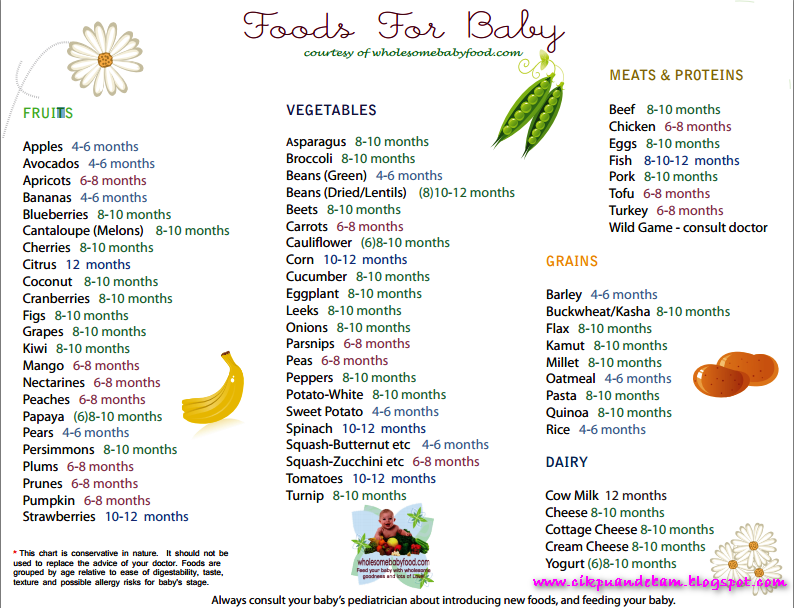 Your baby may eat different foods and amounts.
Your baby may eat different foods and amounts.
Photo credit: Karla Martin for BabyCenter
Lunch for an older baby (8 to 12 months)
The AAP sample menu for a baby 8 to 12 months features a lunch consisting of:
- 4 to 8 tablespoons (1/4 to 1/2 cup) unsweetened plain whole-milk yogurt or cottage cheese, or minced meat
- 4 to 8 tablespoons (1/4 to 1/2 cup) diced or mashed yellow or orange vegetable
Note: This is an example. Your baby may eat different foods and amounts.
Photo credit: Karla Martin for BabyCenter
Afternoon snack for an older baby (8 to 12 months)
The AAP sample menu for a baby 8 to 12 months features an afternoon snack consisting of:
- 4 tablespoons (1/4 cup) diced fruit or unsweetened plain whole-milk yogurt
- 1 whole-grain teething biscuit or cracker
Note: This is an example of an afternoon snack, which babies typically add sometime between 8 and 12 months. Your baby may eat different foods and amounts.
Your baby may eat different foods and amounts.
Photo credit: Karla Martin for BabyCenter
Dinner for older baby (8 to 12 months)
The AAP sample menu for a baby 8 to 12 months features a dinner consisting of:
- 4 tablespoons (1/4 cup) minced or ground poultry or meat, or diced tofu
- 4 to 8 tablespoons (1/4 to 1/2) cup diced, cooked green vegetable
- 4 tablespoons (1/4 cup) noodles, pasta, rice, or potato
- 4 tablespoons (1/4 cup) diced fruit
Note: This is an example. Your baby may eat different foods and amounts.
Photo credit: Karla Martin for BabyCenter
How much should my baby drink once they start eating solids?
Breast milk or formula will fully meet your child's hydration needs until they're about 6 months old. They may start drinking less as solid foods become a bigger part of their diet. Here are typical daily amounts by age – your baby's intake may be different, however.
6 to 8 months: 24 to 32 ounces of formula, or continued breastfeeding on demand
8 to 12 months: 24 ounces of formula, or continued breastfeeding on demand
Water: You can offer your baby water once they start eating solids, but let them self-regulate how much they drink. The Centers for Disease Control and Prevention (CDC) recommends giving babies who are 6 to 12 months old 4 to 6 ounces of water a day, but what your baby decides to drink may vary. They may drink more on a hot day, for example.
Avoid juice: Juice isn't recommended for babies younger than 12 months.
Photo credit: iStock.com / SDI Productions
Your baby has the final say
Keep in mind that these portions are an estimate. The truth is, every baby is different, and there's no set amount of food that's appropriate for every baby at every stage.
If you're worried about whether your baby is eating enough – or too much – the best advice is to look for and respond to signs that your baby is full.
Your baby's doctor will chart their weight gain at regular intervals. If the doctor sees a consistent growth curve and doesn't have other concerns, your baby is most likely eating the right amount of food.
Hungry for more?
Age-by-age guide to feeding your baby
The 10 best foods for babies
The worst foods for babies
Using spices and seasoning in baby food
Was this article helpful?
Yes
No
Elizabeth Dougherty
Elizabeth Dougherty is a veteran parenting writer and editor who's been contributing to BabyCenter since 2015. She's an intrepid traveler, devoted yogi, and longtime resident of Silicon Valley, where she lives with her husband and son.
Advertisement | page continues below
What to feed a child - "Food"
The current situation is a serious test of the strength of family ties and parental love. When schools and kindergartens are closed, moms and dads have to figure out how to entertain children 24 hours a day, what to feed, how to entertain and don't go crazy with it.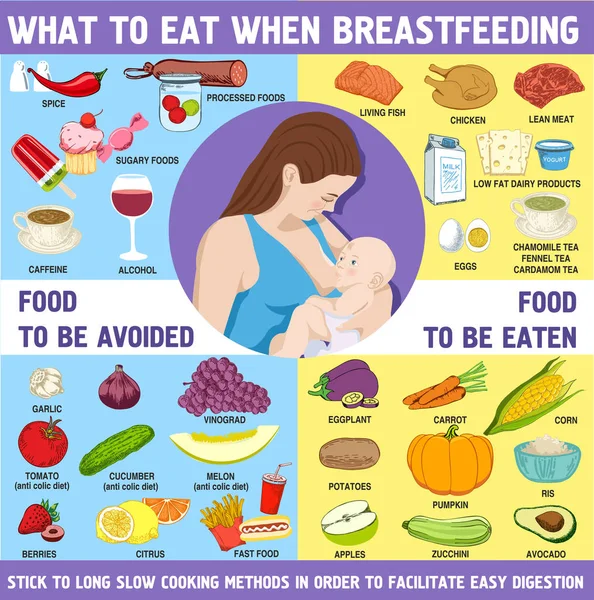 And if you find it difficult to establish a daily life in lack of school canteens, kindergarten lunches and children's menus in restaurants, then you are not alone in the world. For self-doubting dads and moms Liz Ganzor, nutritionist at the Harvard Public Health Institute, wrote the instruction "Baby food in quarantine." Nothing it does not offer anything revolutionary, but to speak again the familiar truths, helping to make food at home boring and complete, will not be superfluous. And in addition to the theory, a little practice - we have collected 11 simple and understandable recipes for dishes from available products, which suitable not only for children, but also for the whole family.
And if you find it difficult to establish a daily life in lack of school canteens, kindergarten lunches and children's menus in restaurants, then you are not alone in the world. For self-doubting dads and moms Liz Ganzor, nutritionist at the Harvard Public Health Institute, wrote the instruction "Baby food in quarantine." Nothing it does not offer anything revolutionary, but to speak again the familiar truths, helping to make food at home boring and complete, will not be superfluous. And in addition to the theory, a little practice - we have collected 11 simple and understandable recipes for dishes from available products, which suitable not only for children, but also for the whole family.
Excerpts from "Baby Food Under Quarantine" by Liz Ganzor:
- Food must be prepared naturally. naturalness implies the rejection of factory semi-finished products for long-term storage, stuffed with preservatives. Family dinner prepared by mom, not a semi-finished product thawed in the microwave, gives the child a feeling of care and security, which is especially important today.

- Learn to calmly accept the ability of the child yourself determine the right amount of food for him. Today he might want to eat less, tomorrow - more, there is nothing wrong with that ... But the psychological blackmailing adults, even if they are well-intentioned, causes the child to perceive food as a means manipulations: here we finish the soup, my mother will be pleased, and they will allow me to play phone. So the child stops “hearing” his own appetite, and here it’s not far from serious eating disorders.
- Until the age of 14, the child literally "eats with his eyes": attractive the appearance of the dishes can make him sympathize with homemade food. Take on weapons "traffic light principle" - shades red, green and yellow arouse emotions in the mind of the child, inciting appetite. This is a handy way to do it the child's menu is complete: so, orange-yellow shades of products (pumpkins, carrots) indicate the presence of beta-carotene, red (tomatoes) - that they contain lycopene is quite a powerful immunity booster, and green signals chlorophyll, a substance which saturates blood cells with oxygen.
- Giving sweets to a child on demand, trying to distract his attention is not the best option. Fast carbohydrates - muffin, chocolate sweets, packaged juices - dramatically increase the glycemic index of the blood, lead to a burst of hyperactivity, and in as a result, you risk getting an uncontrollable monster next to you.
- Try not to deviate from the established diet. Lock the refrigerator (at least in a figurative sense) between the main food intake. Psychologists have proven that a regime failure for a child is always a signal anxiety. Although from time to time it is worth arranging a holiday of disobedience for a child, for example, having a picnic on the balcony so that life at home does not turn into a boring routine.
- Turn cooking food for fun. Have you ever wanted to learn how to bake a cake or make creme brulee? but not enough time? Now it is! And by the way, cooking with kids is fun too. adventure, and the opportunity to teach your child favorite family recipes, and the chance make a dozen stories on instagram.

- Not let yourself become a kitchen slave. Don't get depressed while cooking every day a three-course lunch, breakfast and dinner. You don't want to open restaurant at home. The world is full of dishes which taste better the next day. A soup or stew can be a few days to stand in the refrigerator.
Omelette soufflé
If ordinary fried eggs, scrambled eggs and other scrambled eggs have already breakfast you can cook an omelette in the form of a delicate airy soufflé. Essentially, this filling for french pie quiche lauren, only without the dough. The recipe attracts variety: today you can add ham to it, tomorrow - fried vegetables, smoked or salted fish or any meat, not forgetting to chop it finely.
Recipe
Breakfast French cuisine
213 14 4901
Alexey Zimin
11 ingredients 25 minutes
Chicken Noodle Soup
Simple and healthy chicken soup. The one that was once cooked caring mothers for us: in a clear broth, with freckles of fried onions and carrots. But a small touch - a clove added to the broth - distinguishes it from fresh catering food. Sudden separation from the office is a great excuse learn how to make noodles with your own hands, with it the soup will be even tastier and cooked quite at home.
But a small touch - a clove added to the broth - distinguishes it from fresh catering food. Sudden separation from the office is a great excuse learn how to make noodles with your own hands, with it the soup will be even tastier and cooked quite at home.
Recipe
Soups Russian kitchen Children's menu step -by -step recipes
24 7 667
Author: Food
10 Ingredients 2 hours 9000
You won’t get far on chicken noodles alone, so here’s another soup option for all times. Made from improvised products, nourishing due to pearl barley cereals and potatoes, not dull because of the pickle. In addition, you will be attach a pickle from an open can of cucumbers - it is added to the soup in the very end.
Recipe
Soups Russian kitchen steps up
12 1 360
Author: Food
14 Ingredients 3 hours
9000 Cottage cheese and buckwheat are important elements healthy children's menu. In order not to get bored on a monotonous diet, you can take and "marry".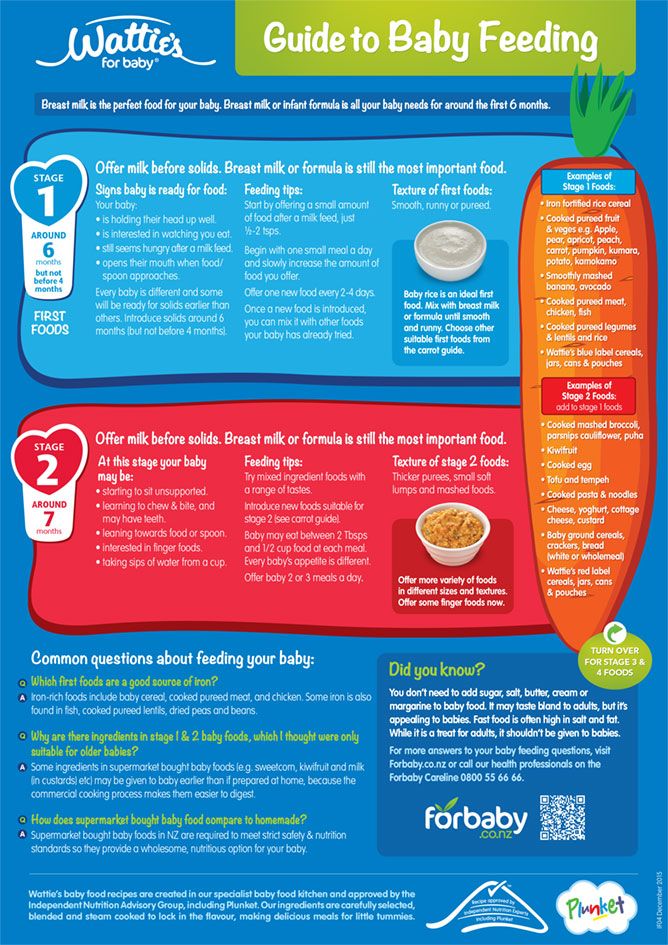 Buckwheat only needs to be boiled, everything is mixed and loaded into multicooker that will do all the work for you. If multicookers on the farm no, you can bake the casserole in the oven - at 180 degrees, 20 minutes is enough. And in as a vitamin filling, use apple slices, nuts and dried fruits. 9Redmond_receipts
Buckwheat only needs to be boiled, everything is mixed and loaded into multicooker that will do all the work for you. If multicookers on the farm no, you can bake the casserole in the oven - at 180 degrees, 20 minutes is enough. And in as a vitamin filling, use apple slices, nuts and dried fruits. 9Redmond_receipts
Content - meat, cabbage, rice - it's quite pigeons. But in a simplified version: there is no need to boil a head of cabbage in boiling water and wrap the minced meat in a cabbage leaf. Everything is just finely chopped and fried in a pan, and then lightly stewed in broth. It turns out Ideal even for inexperienced parents. Cilantro, if your child cannot stand it, can be easily replaced with parsley.
Recipe
Main dishes of world kitchen step recipes
87 15 1810
Author: Alexey Zimin
16 Ingredients 40 minutes 9000
Textbook children's dish — meatballs with rice, codenamed hedgehogs. In the role of needles - rice with long grains.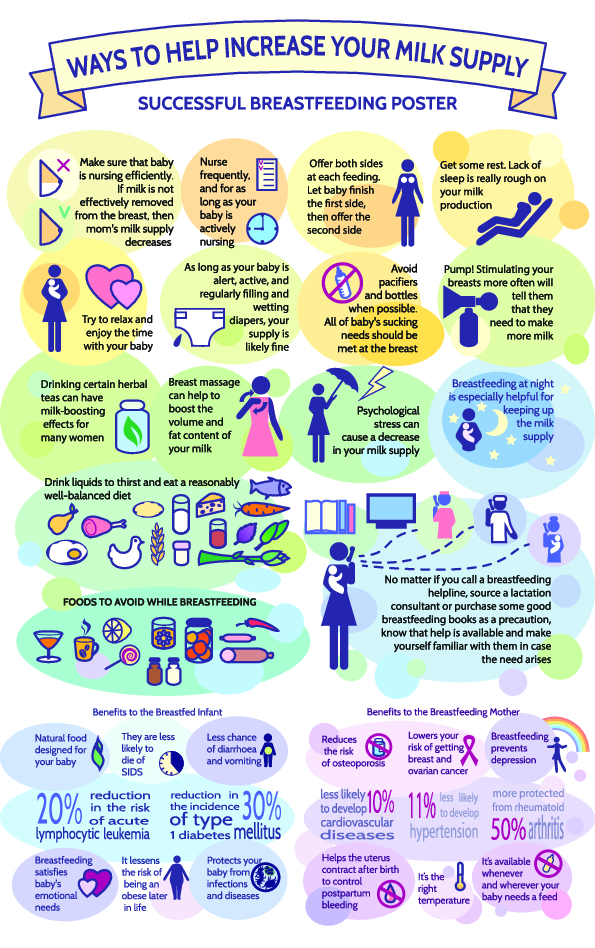 The dish is good because it is very easy to prepare, and also contains approximately equal amount of proteins and carbohydrates. You can serve hedgehogs without garnish, with the same sauce in which they were stewed.
The dish is good because it is very easy to prepare, and also contains approximately equal amount of proteins and carbohydrates. You can serve hedgehogs without garnish, with the same sauce in which they were stewed.
Recipe
Main dishes Russian cuisine Step by step recipes
21 1 549
Author:Food
10 ingredients with 1 hour macaroni 08
All, with rare exceptions, children tied to hefty portions of baked macaroni with golden cheese crust. And it's not just pasta. - a whole casserole! This dish is known all over the world mac&cheese, and in it, of course, a million calories. But children, especially active ones, are not afraid. Although if If you want to lighten the plot, replace a third of the pasta with cauliflower or broccoli florets.
Recipe
Main dishes American kitchen step -by -step recipes
63 22 2218
Author: Food
9 Ingredients 55 minutes 9000
A very convenient dish in everyday life - yesterday's potato is suitable for it. puree that looks great in zrazy. Then the plot can be changed to infinity: stuff zrazy not with an egg, but with mushrooms or minced meat with green peas. And sauces vary from tomato and sour cream to tender, but not heavy bechamel sauce.
Recipe
Main dishes Belarusian kitchen step recipes
20 6 1684
Author: Food
10 Ingredients 40 minutes 9000
Greetings from childhood, which is even more valuable to parents than their heirs. Its value is rather not dietary, but psychological - in that sense that it is precisely such nostalgic things that bring us back to that distant a time when we felt carefree and completely protected from different adversity, which helps to cope with stress. By the way, you can bake them with children to keep them busy.
Recipe
Pastries and desserts Russian cuisine
86 17 881
Author: Alena
Vitamin recharge, which, if you know a couple of simple things, the maximum reminiscent of a compote of fresh berries.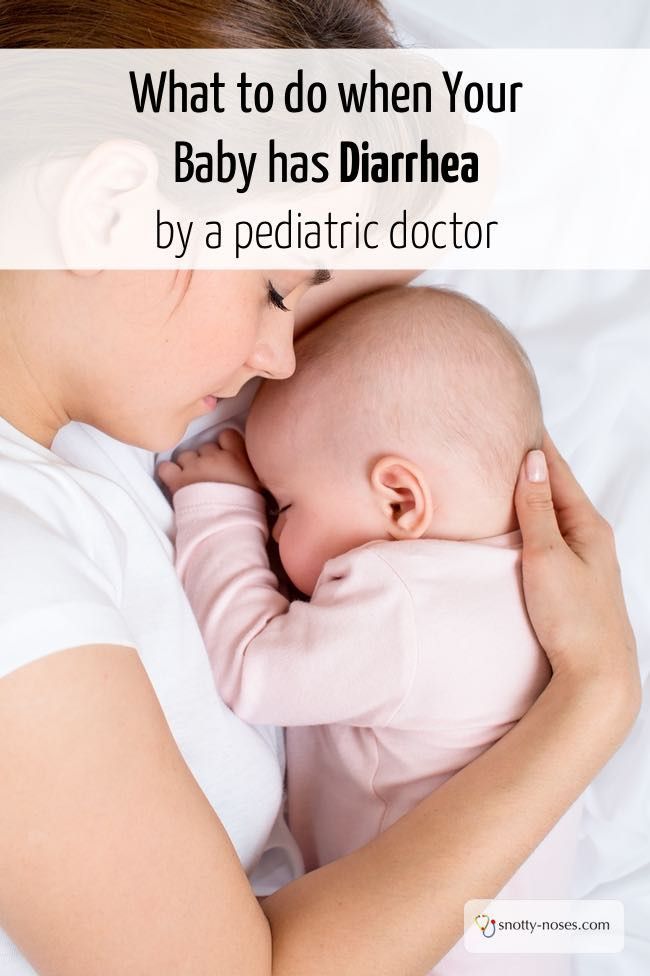 Here's what's important: do not defrost the berries first, then they will not turn into porridge, and cook compote no longer than five minutes. Then take it off the heat and let it cool down. and brew under the lid to fully reveal the fruity taste and aroma. brew compote immediately in large pots - for children it is healthier than sugary sodas.
Here's what's important: do not defrost the berries first, then they will not turn into porridge, and cook compote no longer than five minutes. Then take it off the heat and let it cool down. and brew under the lid to fully reveal the fruity taste and aroma. brew compote immediately in large pots - for children it is healthier than sugary sodas.
Recipe
Drinks Russian cuisine
106 11 934
Author:Anna Yushchenko
3 ingredients 040 minutes from terrible children
The secret weapon for the most extreme case or the holiday of disobedience as it is. Recipe taken from the book "What Parisians Eat" by Anne Martinetti, a Frenchwoman working in the genre "Culinary ins and outs of literary plots". The book is preceded by a quote from play "Terrible Children" by Jean Cocteau: "Marietta took her responsibilities to heart. <…> A Breton would, of course, prefer that she was given the opportunity to cook good bourgeois dishes, but she forgave by her habits and without dispute, she obeyed the whims of children. <…> A enfan terribly - terrible children - preferred to stay at home and eat dishes that they invent themselves, mixing products contrary to all rules and decency. Not Does this quote sound surprisingly relevant again today?
<…> A enfan terribly - terrible children - preferred to stay at home and eat dishes that they invent themselves, mixing products contrary to all rules and decency. Not Does this quote sound surprisingly relevant again today?
Recipe
Oaks French cuisine
1 0 42
Author: Food
12 Ingredients 30 minutes
90,000 from 1 year and older - than and how to feed a small childFrom 1 year old and older - this is the age when the child learns to walk and talk, masters new movements and learns to eat on his own. And this is also the age when the baby learns to say “no”, and may well refuse the usual foods or start eating less.
In this article, we offer you 10 general recommendations on what and how to feed a child aged one year and older.
1. Trust your baby
If your baby doesn't want to eat, he may just not be hungry. From the age of 1 year, children can eat less than before, and there is nothing to worry about.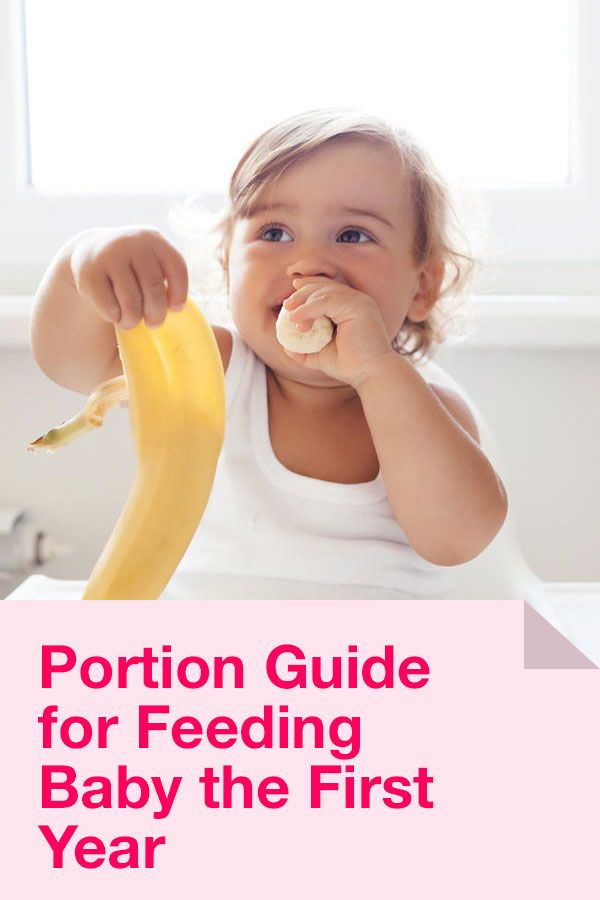 If the child is healthy, he himself knows when and how much he needs to eat. Appetite and taste preferences at this age can often change - and this is also nothing to worry about.
If the child is healthy, he himself knows when and how much he needs to eat. Appetite and taste preferences at this age can often change - and this is also nothing to worry about.
2. Let's have a choice
Even such a small child wants to have the right to choose. Let the baby choose what he wants to eat. Take the little helper with you to the supermarket, where he can choose vegetables and fruits, yogurt or children's cheese. If the child has chosen a product, and then does not want to eat it, do not insist. Remember that any useful product can be replaced by another, no less useful.
3. At the dinner table - lunch only
During meals, put away phones and other devices, turn off the TV, and leave children's toys in the children's room.
See also: Eating your child healthy - 10 ideas to achieve it
4. Food is just food
Don't use food as a reward or punishment. If you promise a child a sweet dessert once for eating vegetables or porridge, then he will eat vegetables or porridge - this time. But will he then want to eat vegetables and porridge without remuneration?
But will he then want to eat vegetables and porridge without remuneration?
5. Small child - small portion
Remember that a one-year-old child does not need much food - definitely less than an adult. Give the baby a small portion. If he wants more, he will ask for more. As a rule, children at this age themselves know how much they need to eat.
6. Give it time
If you offer your child a new healthy product (fruits, vegetables), be prepared for the fact that the baby will fall in love with this product immediately. Moreover, if the product is new, the child may not know how to eat it properly. Show me how to do it.
See also: Vegetables on a child's plate - how to make your child love vegetables
7. Stay calm and positive
This age is also difficult for parents. Get ready for a mess at the table and the fact that yesterday's favorite products can fly to the floor today. It may also be that the child wants to eat only one food and refuses all the others - do not worry, this will not last forever.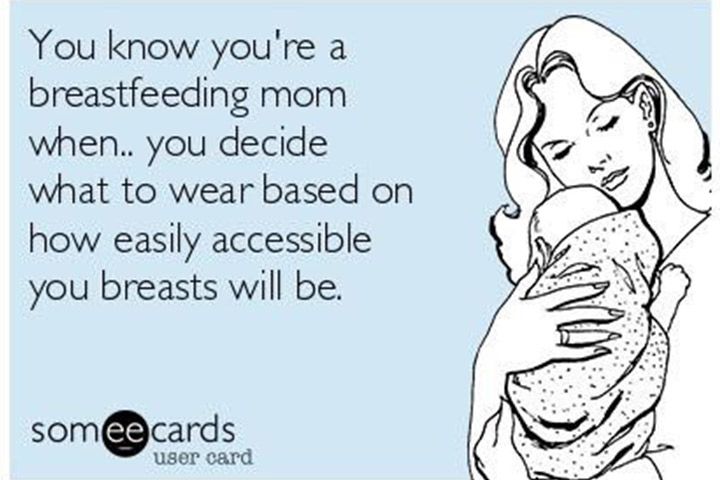
8. Choose the Right Foods
Here are some healthy snack ideas for kids: fruits, vegetables, cottage cheese, baby yogurt, milk smoothies. If you need to make a sweet dessert for the crumbs, try fruit salad with yogurt, rice pudding with pear pulp, pancakes with fruits and berries. You should not give your child foods that are high in fat and sugar: cakes, chocolate, sweets, chips, fast food, sweet carbonated drinks.
9. More joy and fun
Try to make your child associate meal times with pleasant emotions. Take your child to the dinner table and have family dinners as often as possible. Come up with some unusual dish or decorate a familiar dish in an unusual way. Take your child with you to the kitchen and to the supermarket - he will be interested. For more information on how to keep a child busy in the kitchen, read our article Little Cook - how and how to keep a child busy in the kitchen .
10.

